Liza Perrat's Blog, page 27
October 16, 2012
Mad Women of the Hell of La Salpêtrière

In her generous review of Spirit of Lost Angels on The Queen's Quill Review, Andrea Connell's comment on La Salpêtrière prompted me to write a short piece about this asylum for “insane and incurable women”: To me, this was perhaps the most fascinating portion of the story - descriptions of the appalling conditions under which the women were kept, the rivalries that developed among cell mates, the rules one had to learn in order to survive this prison. The narrative was stark and believable and, believe it or not, educational. Since I finished the book, I’ve been looking up the history of the Salpêtrière Hospital, intrigued at how low mental health care and the care of women had deteriorated at that time.
As an author, I too, found the asylum parts of the story the most fascinating to write about.
Located in the 13th arrondissement of Paris, this building was named La Salpêtrière due to its origins as a producer and storage area for saltpeter (used to make gunpowder).
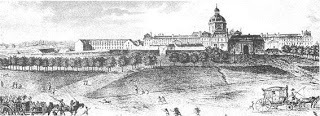
For many years it was then known as a cruel and harsh place to which people suffering from mental health problems were sent … as well as various other “conditions” not considered suitable for society: beggars, prostitutes, protestants, epileptics, orphans, Jews, criminals, drunks, witches, depressives, blind women, adultresses, homosexuals, thieves, magicians, idiots, suicidals, bohemians, cretins. The old, the young, the children, all imprisoned together, sent there by families, husbands, neighbours.
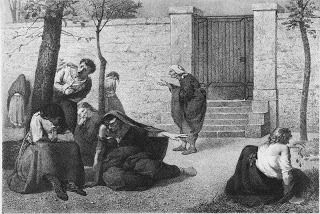
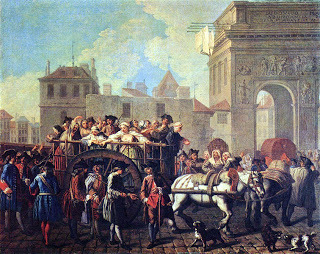 On Sundays, prostitutes were rounded up and carted off to La Salpêtrière
On Sundays, prostitutes were rounded up and carted off to La SalpêtrièreIn the late 18th century, Dr. Philippe Pinel, child of 18th century enlightenment, finally did away with the women’s chains and the approach to mental disease began to change. Today, Dr. Pinel’s sculptural monument stands before the main entrance in Place Marie-Curie, Boulevard de L'Hôpital.
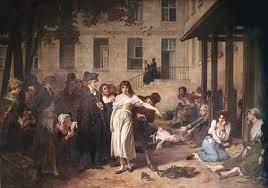 Dr. Pinel removing patient's chains.
Dr. Pinel removing patient's chains.In the second half of the 19th century, when Dr. Jean-Martin Charcot took over the department, La Salpêtrière became world famous as a psychiatric centre, and students came from all over the world to listen to Charcot's lectures. Among them was a young man by the name of Sigmund Freud.
Despite its modern-day state of the art facilities, the hospital is still littered with memories, some of the original structures remaining as a bleak reminder of how things use to be.
During my research into La Salpêtrière, I stumbled upon a beautifully poetic little book – Les Folles d’Enfer de la Salpêtrière (The Mad Women of La Salpêtrière Hell) written by talented French sculptress and illustrator, Mâkhi Xenakis.
Invited to exhibit at the La Salpêtrière hospital in Paris in 2004, Mâkhi Xenakis discovered in the hospital archives the hellish imprisonment there of thousands of women since the time of Louis XIV. This discovery led her to pen a heart-breaking account of the tragic inmates, in Les Folles d’Enfer de la Salpêtrière, and to install 260 amazing sculptures in the hospital chapel and the gardens:

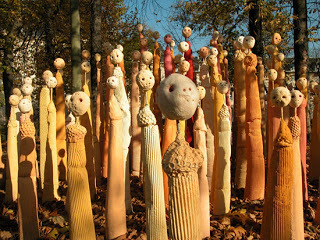

I found this link, and video (in French) both moving and enlightening.
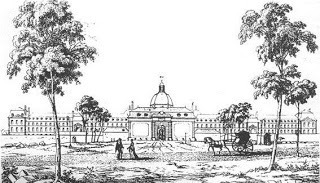
Published on October 16, 2012 07:10
October 11, 2012
Many thanks to Andrea Connell and The Queen's Quill Revie...
Many thanks to Andrea Connell and The Queen's Quill Review for a generous review of Spirit of Lost Angels. Andrea's comments have inspired me to write a blog post about La Salpêtrière asylum in Paris that features in this story. COMING SOON...
Published on October 11, 2012 22:40
October 9, 2012
Autumn Chestnuts and Fortified Villages
Keen as ever for a break from internet research, and to seek out more tangible sources of documentation for my current book, I recently paid a visit to la Maison d’Expositions de L’Araire.
As I headed towards this historical society stone building, admiring the panoramic view across the Yzeron valley to the city of Lyon, it was obvious autumn had sneaked up on me again while I wasn’t looking. In this rural heart of the Monts du Lyonnais, flame, mustard and crimson-coloured leaves almost outdid the green, and I drew my cardigan around me against the damp nip in the air.
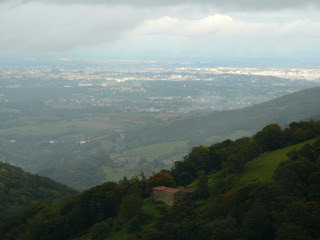
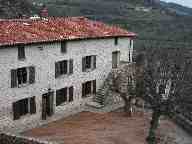
La Maison d’Expositions de L’Araire is a humble place, the volunteers who run it always offering a welcoming smile and more than happy to answer my myriad of questions. An elderly woman beckoned me inside, towards the hearth, and the sweet aroma of roasting chestnuts filled my nostrils. She rattled her poker about in the flames as we talked about the weather, and how suddenly the summer had left us for another year. After what I hoped was a polite interval, I bade her au revoir and headed off towards the exhibitions.
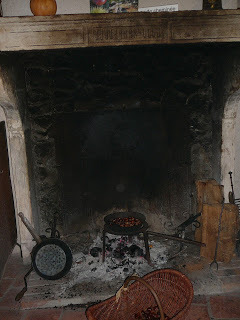
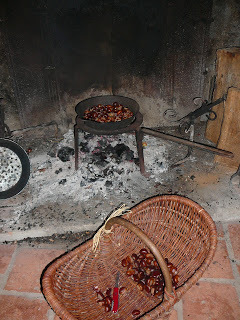
La Maison de L’Araire boasts permanent exhibitions of an old silk-weaving loom, and a model of a Roman aqueduct, from when the Romans inhabited this part of France, but it also features temporary exhibits and since my novel-in-progress is set in the 14th century, I was particularly interested in the model-sized fortified villages.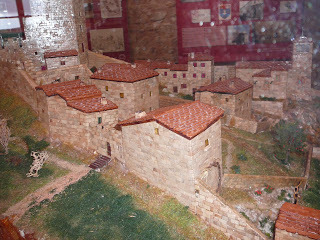

During the Hundred Years’ War (1337-1453), the inhabitants of this west Lyon region constructed high stone walls around their villages to protect them from the hordes of pillaging, plundering soldiers. This fortification was named the vingtain, as each peasant was required to pay a twentieth (une vingtième) of his harvest towards its construction and upkeep. I pictured the people complaining about this extra tax; yet another to leech their meagre earnings. But I also imagined them working in the fields, startled and frightened as the cries of bandits reached their ears, and hurrying off to the relative protection of their fortified village.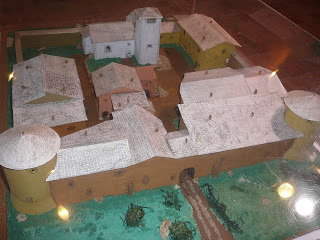
I took the usual photographs, filled my notebook, thanked the historical society volunteers, and hurried off through the early dusk to join my friends for an aperitif in the village bar.
As I headed towards this historical society stone building, admiring the panoramic view across the Yzeron valley to the city of Lyon, it was obvious autumn had sneaked up on me again while I wasn’t looking. In this rural heart of the Monts du Lyonnais, flame, mustard and crimson-coloured leaves almost outdid the green, and I drew my cardigan around me against the damp nip in the air.


La Maison d’Expositions de L’Araire is a humble place, the volunteers who run it always offering a welcoming smile and more than happy to answer my myriad of questions. An elderly woman beckoned me inside, towards the hearth, and the sweet aroma of roasting chestnuts filled my nostrils. She rattled her poker about in the flames as we talked about the weather, and how suddenly the summer had left us for another year. After what I hoped was a polite interval, I bade her au revoir and headed off towards the exhibitions.


La Maison de L’Araire boasts permanent exhibitions of an old silk-weaving loom, and a model of a Roman aqueduct, from when the Romans inhabited this part of France, but it also features temporary exhibits and since my novel-in-progress is set in the 14th century, I was particularly interested in the model-sized fortified villages.


During the Hundred Years’ War (1337-1453), the inhabitants of this west Lyon region constructed high stone walls around their villages to protect them from the hordes of pillaging, plundering soldiers. This fortification was named the vingtain, as each peasant was required to pay a twentieth (une vingtième) of his harvest towards its construction and upkeep. I pictured the people complaining about this extra tax; yet another to leech their meagre earnings. But I also imagined them working in the fields, startled and frightened as the cries of bandits reached their ears, and hurrying off to the relative protection of their fortified village.

I took the usual photographs, filled my notebook, thanked the historical society volunteers, and hurried off through the early dusk to join my friends for an aperitif in the village bar.
Published on October 09, 2012 06:16
October 2, 2012
Triskele Books and Spirit of Lost Angels get a mention in...
Published on October 02, 2012 09:41
September 30, 2012
Thank you to Devon Marshall for generous Goodreads review...
Published on September 30, 2012 12:16
September 29, 2012
Many thanks to Teresa of Lovely Treez for her generous re...
Published on September 29, 2012 00:18
September 25, 2012
THE IDEAL CHAPEL


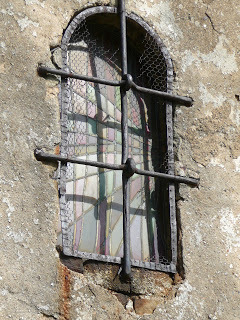
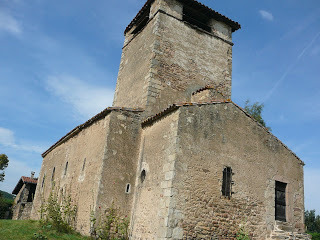
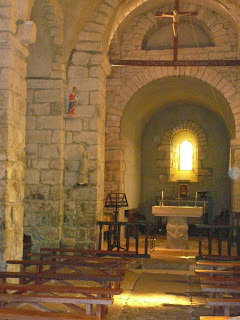
Last Sunday dawned warm and sunny, so we stuffed cheese, saucisson, baguettes and water into the backpack and headed up the track behind the house, into the foothills of the Monts du Lyonnais. After several hours tramping up and down valleys, and through forests, we reached the hamlet of Châteauvieux, with its wide view over the Yzeron valley on one side, and the city of Lyon on the other. Châteauvieux boasts not only a history dating back to Roman times, but also an 11thcentury chapel, which was my real motive for our day-long hike. For this medieval edifice seemed the ideal chapel for Angel of Roses – my current novel, set in this rural area west of Lyon during the 14th century plague years. As I peered into the chapel, I felt that twinge of excitement, anticipation and nervousness, when a story starts to come alive. It was as if, in that dim and dusty interior, I could see the villagers hunched on the straw-covered flagstones, the elderly and infirm lined up on benches along the walls, all eyes on the priest. I could hear the priest telling them that Black Death had come to the village because they were all such terrible sinners, and now they must pay for their sins, and repent. And, from her glorious pedestal, I shivered at the implacable stare of the Virgin Mary.Not a single tombstone is left standing in the cemetery, but as I walked across the grass, the silence broken only by the gentle breeze, it seemed those ancient spirits were still there, crouched in the shadow of the stone walls, watching my every move, guarding their sacred site. I expected to see a wimpled face staring from a cracked, stained-glass window. ‘Who are you?’ she would say. ‘Where do you come from, dressed like that?’ In that instant, I wished for time-travel. I’d have loved to have been in their midst, experiencing their life and times, first-hand. But only for a few hours mind, then buzz me back to the safety of the 21st century, thanks very much!We left the chapel to its ancient keepers and their secrets, and continued on up the hill towards the village of Yzeron, calling in on some old friends along the way:
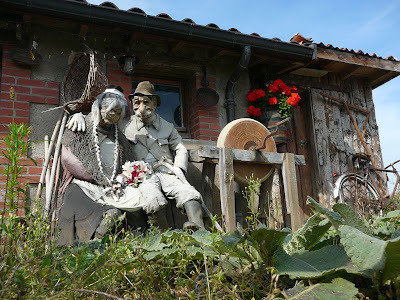
Published on September 25, 2012 08:30
September 24, 2012
Maiden's Court Interview
Many thanks to Heather Rieseck for interviewing me on The Maiden's Court blog about writing Spirit of Lost Angels.
Published on September 24, 2012 00:37
Maiden's Court Inteview
Many thanks to Heather Rieseck for interviewing me on The Maiden's Court blog about writing Spirit of Lost Angels.
Published on September 24, 2012 00:37
September 18, 2012
It Never Rains...
Published on September 18, 2012 07:27




